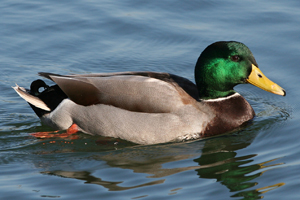Dutch scientists sequence wild duck genome

After having sequenced the genomes of several birds including the zebra finch, the chicken and the turkey, scientists have now succeeded in mapping the genome of the mallard (a.k.a. wild duck).
The total DNA sequence of this waterfowl shows the bird’s interaction with various bird flu viruses (influenza A) over extended periods of time. This provides good leads for further research into exactly how this virus affects birds, and in the long-term, also humans.
Part of the infection mechanism and some of the physical reactions in birds are the same as in humans. This is written in an article by an international research team, including researchers from Wageningen University, the Netherlands which was published in Nature Genetics on 10 June.
Mallards (Anas platyrhynchos) constitute a natural reservoir for bird flu. Researchers have already discovered 25 strains of influenza A in this species of waterfowl. The birds themselves are rarely affected by the viruses, but since the emergence of the H5N1 strain, the virus has caused immense damage among poultry in some sixty countries. The fact that the virus can be transmitted to humans and has already claimed several hundred lives makes it even more of a concern. It is a continual threat, as the virus can change its genetic make-up in the mallard, thus creating a perpetual stream of new virus strains, any of which could be deadly to humans and animals.
The research team, which includes Wageningen researchers Martien Groenen, Richard Crooijmans and Robert Kraus, identified some 19,000 protein-coding genes in the genome of the mallard. This corresponds with the number in genomes of other birds sequenced previously, and is approximately 3,000 fewer than the average number found in mammals, including humans. The team used a 10-year-old Peking duck for the sequencing.
When the bird flu virus comes into contact with tissue (usually the lungs) of the mallard, it prompts a whole chain of reactions. After initial contact with the virus, signalling proteins (cytokines) sound a series of alarms around the bird’s body. Immune cells, such as white blood cells, migrate to the source of the infection via the blood and tissues. The body temperature rises in an attempt to increase its internal metabolism and disturbs the ideal temperature for the virus. Infected cells ‘commit suicide’ or are removed by the body’s own cells. The body needs a whole army of genes to mobilise this chain of reactions.
“When a duck is infected with the flu virus, thousands of genes are activated. Many of them are also present and active in humans”, explains Martien Groenen. “However, studying the differences how ducks and humans fight an influenza infection will help us to find ways of controlling the infection process with medication in humans, and ultimately reduce the number of fatalities.”
Source: Wageningen University, Animal Breeding and Genetics













